
Economics_-_New_Ways_of_Thinking
.pdf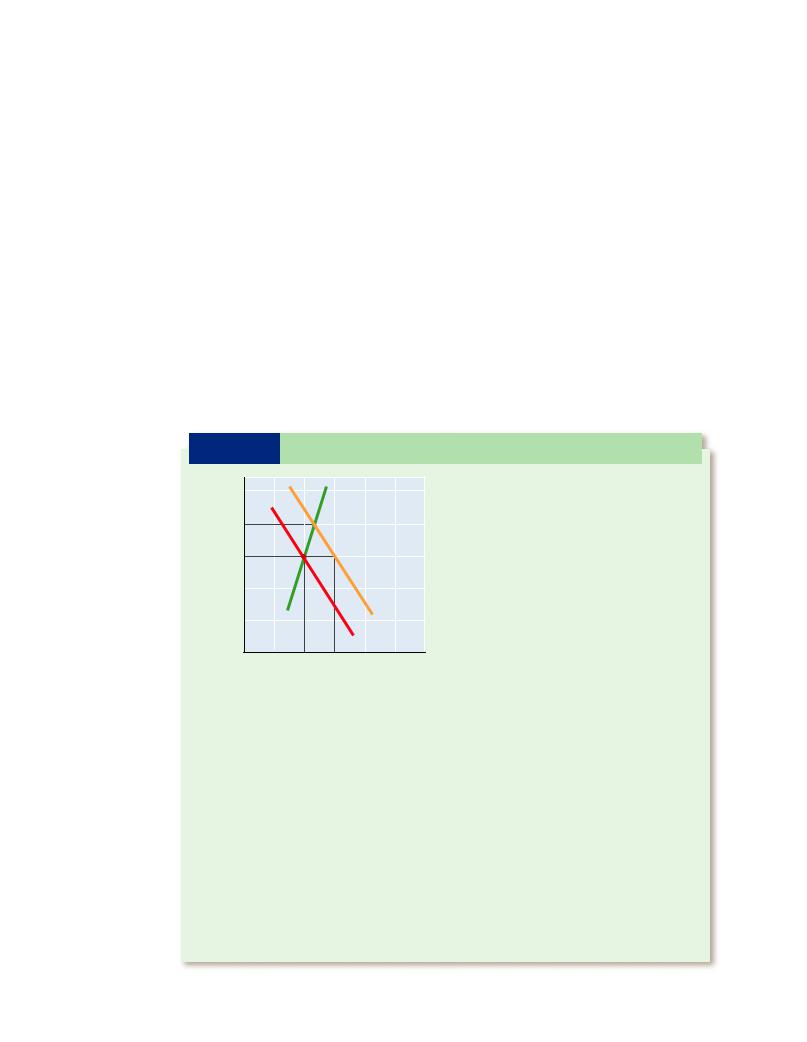
Demand Changes Cause Changes to Equilibrium Price
Exhibit 6-3(a) below shows the demand for and supply of television sets. The original demand curve is D1, the supply curve is S1, equilibrium is at point 1, and the equilibrium price is $300. Now suppose the demand for television sets increases. (Recall from Chapter 4 the factors that can shift the demand curve for a good: income, preferences, prices of related goods, number of buyers, and future price.) The demand curve shifts to the right, from D1 to D2. D2 is now the relevant demand curve. At $300 per television, the quantity demanded (using the new demand curve, D2) is 300,000, and the quantity supplied (using the one and only supply curve, S1) is 200,000.
Because the quantity demanded is greater than quantity supplied, a shortage exists in the television market. Price then begins to rise. As it does, the television market moves to point 2, where it is in equilibrium again. The new equilibrium price is $400. We conclude that an increase in the demand for a good will increase price, all other things remaining the same.
Now suppose the demand for television sets decreases as in Exhibit 6-3(b). The demand curve shifts to the left, from D1 to D2. At $300, the quantity demanded (using the new demand curve, D2) is 100,000, and the quantity supplied (again using S1) is 200,000. Because quantity supplied is greater than quantity demanded, a surplus exists. Price begins to fall. As it does, the television
A change in equilibrium price can be brought about by (a) an increase in demand,
(b) a decrease in demand, (c) an increase in supply, or
(d) a decrease in supply.
E X H I B I T 6-3 Changes in the Equilibrium Price of Television Sets
|
|
|
|
S1 |
|
|
|
|
|
|
|
|
|
|
|
|
|
|
|
|
An increase in |
|
|
|
|
|
S1 |
|
|
|
|
|
$400 |
|
|
2 |
demand brings |
|
|
|
|
|
A decrease in |
|
|||
|
|
|
about a rise in |
|
|
|
|
|
|
||||||
|
|
|
|
|
|
|
|
|
|
||||||
|
|
|
1 |
|
equilibrium price. |
|
|
|
|
|
demand brings |
|
|||
Price |
$300 |
|
|
|
|
|
Price |
$300 |
|
1 |
about a fall in |
|
|||
|
|
|
|
|
|
|
equilibrium price. |
|
|||||||
|
|
|
|
|
|
|
|
|
|
|
|||||
|
|
|
|
|
|
|
|
|
2 |
|
|
|
|
||
|
|
|
|
|
|
|
|
|
$200 |
|
|
|
|
|
|
|
|
|
|
|
|
|
|
|
|
|
|
|
|
|
|
|
|
|
|
|
|
D2 |
|
|
|
|
|
|
|
|
|
|
|
|
|
|
D1 |
|
|
|
|
|
|
D2 |
D1 |
|
|
|
|
|
|
|
|
|
|
|
|
|
|
|
|
|
|
|
0 |
100 |
200 |
300 |
400 |
500 |
600 |
|
0 |
100 |
200 |
300 |
400 |
500 |
600 |
Quantity (thousands) |
Quantity (thousands) |
|
|
|
|
(a) |
|
|
|
|
|
|
|
(b) |
|
|
|
|
|
|
|
S1 |
|
|
|
|
|
|
S2 |
|
|
|
|
|
|
|
|
|
S2 |
|
|
|
|
|
|
S1 |
|
|
|
|
|
|
|
|
|
|
|
|
|
2 |
|
|
|
|
|
|
|
|
|
|
|
|
|
|
$400 |
|
A decrease in |
|
|||
|
|
|
|
|
An increase in |
|
|
|
|
|
|||||
|
|
|
1 |
|
|
|
|
|
|
|
|||||
|
|
|
|
|
|
|
|
|
supply brings |
|
|||||
Price |
$300 |
|
|
supply brings |
|
Price |
$300 |
|
1 |
|
|||||
|
|
|
|
|
about a rise in |
|
|||||||||
|
|
|
about a fall in |
|
|
|
|||||||||
|
|
|
2 |
|
|
|
|
equilibrium price. |
|
||||||
|
|
|
equilibrium |
|
|
|
|
|
|||||||
|
$200 |
|
|
|
|
|
|
|
|
|
|
|
|
||
|
|
|
|
price. |
|
|
|
|
|
|
|
|
|
|
|
|
|
|
|
|
D1 |
|
|
|
|
|
|
|
D1 |
|
|
|
0 |
100 |
200 |
300 |
400 |
500 |
600 |
|
0 |
100 |
200 |
300 |
400 |
500 |
600 |
|
|
Quantity (thousands) |
|
|
|
Quantity (thousands) |
|
||||||||
|
|
|
|
(c) |
|
|
|
|
|
|
|
(d) |
|
|
|
134 Chapter 6 Price: Supply and Demand Together
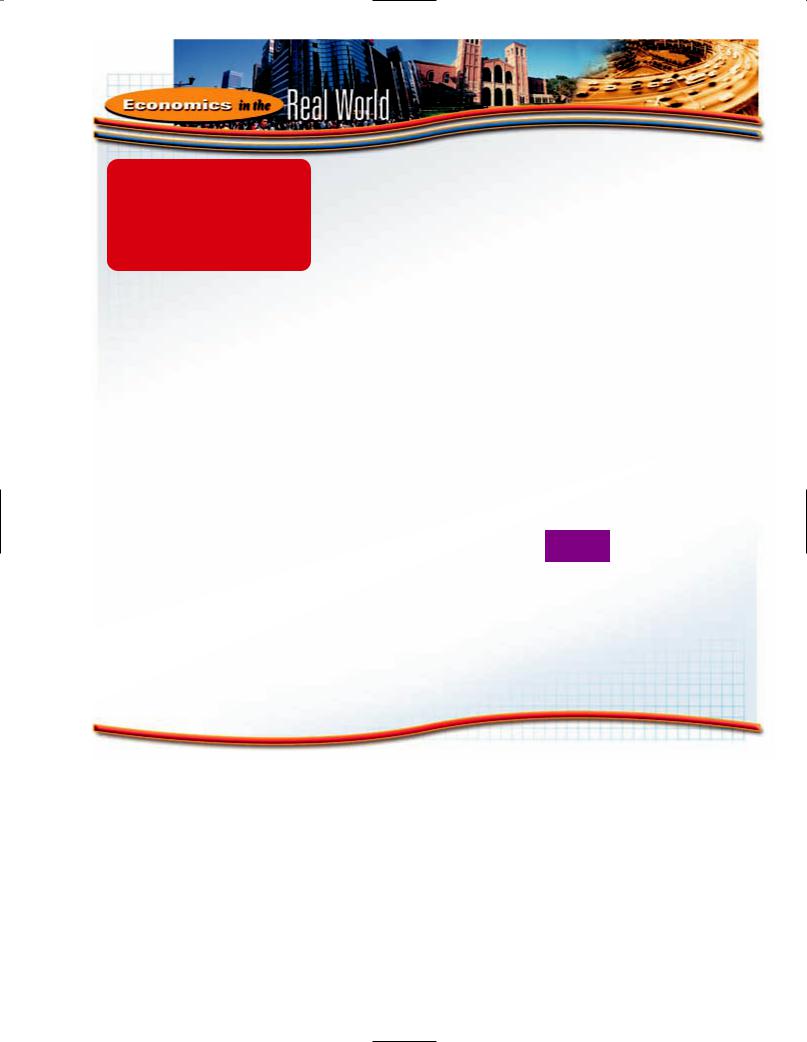
Do You Speak
Economics?
??????????????????
Various language translators are available on the Web.
For example, with a Spanish-English translator, you simply key in a statement in English, then click “Free Translation,” and the statement is translated into Spanish. “Are you having a good morning?” becomes “¿Tiene usted un buenos días?”
Suppose an English-to- Economics translator were available. How would various statements (that you might hear every day) be translated? Here are a few examples. Do you think it might be in your personal interest to learn to speak Economics?
English
She is very popular in school.
Economics
The demand to be around her is high relative to the demand to be around others.
English
We have to do more in Mr. Johnson’s class to get an A than we have to do in Mr. Meyer’s class to get an A.
Economics
The price to get an A in Mr. Johnson’s class is higher than the price to get an A in Mr. Meyer’s class.
English
I can’t get into that class, because it has no open spots.
Economics
The quantity demanded of seats in that class is greater than the quantity supplied, resulting in a shortage of seats in that class.
English
They did away with fast food at the school.
Economics
The supply of fast food at the school dropped to zero.
English
Jake can only come to the party if he brings some food; of course, Stephanie doesn’t have to bring anything.
Economics
The price is higher for Jake to attend the party than for Stephanie.
English
Do you want to dance?
Economics
I have a demand to be around you. Do you have a demand to be around me?
English
She broke up with me.
Economics
Her demand for me fell to zero.
One purpose of these examples is to show
you how much of what you hear in a day has some economic content. Economics appears in more places than you might think. Can you identify some everyday phrase or statement that can easily be translated into “econospeak”?
market moves to point 2, where it is in equilibrium again. The new equilibrium price is $200. A decrease in the demand for a good will decrease price, all other things remaining the same.
 If you go to the Boston Red Sox Web site you will be able to buy tickets (that some ticket holders want to sell) for various games played at Fenway Park. On the day we checked, the price of a seat in
If you go to the Boston Red Sox Web site you will be able to buy tickets (that some ticket holders want to sell) for various games played at Fenway Park. On the day we checked, the price of a seat in
Section 36, Row 19 was $105 if you wanted to see the game between the Boston Red Sox and the Atlanta Braves. If you wanted to see a game between the Boston Red Sox and the New York Yankees the price of a seat in the same section and row was $205. The number of seats in Fenway Park is the same for all games. In other words, the supply curve of seats at Fenway Park is vertical at a little more than 36,000 seats. The demand for games at Fenway differs from game to game,
Section 1 Supply and Demand Together 135

upply and demand are at Swork in auctions that take
place on the World Wide Web. www.emcp.net/ebay is the address of a
popular auction site, eBay. By using the drop-down menu on the left side of your screen, you can browse for various items. Click on “Art,” followed by “Antique, Pre-1900.” Notice what specific items are being auctioned. Be sure to notice the highest bid for each item, the number of bids, and when the auction ends.
though. For example, the demand for a game with the Yankees is usually greater than the demand for a game with the Braves (in other words, the demand curve for a Yankees game lies to the right of the demand curve for a Braves game). As a result, the ticket price for a Red Sox–Yankees game is usually higher than the ticket price for a Red Sox–Braves game.
 A hotel in Miami Beach charges $150 a night for a room in June but $250 a night in January. Why the difference? A room is a room is a room, isn’t it? Well, yes, a room is a room, but the demand for the room is different at different times of the year. Winter is the “high season” in Miami Beach, because people all over the United States want to escape the cold weather where they live and vacation for a few days in warm Miami Beach. Higher demand translates into higher price.
A hotel in Miami Beach charges $150 a night for a room in June but $250 a night in January. Why the difference? A room is a room is a room, isn’t it? Well, yes, a room is a room, but the demand for the room is different at different times of the year. Winter is the “high season” in Miami Beach, because people all over the United States want to escape the cold weather where they live and vacation for a few days in warm Miami Beach. Higher demand translates into higher price.
Supply Changes Cause Changes to
Equilibrium Price
Now let’s return to Exhibit 6-3. Suppose the supply of television sets increases. (Recall the discussion in Chapter 5 of the factors that can shift the supply curve for a good, including resource prices, technology, taxes, and so on.) The supply curve in Exhibit 6-3(c) shifts to the right, from S1 to S2. At $300, the quantity supplied (using the new supply curve, S2)
is 300,000, and the quantity demanded (using D1) is 200,000. Quantity supplied is greater than quantity demanded, so a surplus exists in the television market. Price begins to fall, and the television market moves to point 2, where it is in equilibrium again. The new equilibrium price is $200. Thus, an increase in the supply of a good will decrease the price, all other things remaining the same.
Now suppose the supply of television sets decreases, as in Exhibit 6-3(d). The supply curve shifts leftward, from S1 to S2. At $300, the quantity supplied (using S2) is 100,000, and the quantity demanded (using D1) is 200,000. Because quantity demanded is greater than quantity supplied, a shortage exists in the television market. Price begins to rise, and the television market moves to point 2, where it is again in equilibrium at the new equilibrium price of $400. We conclude that a decrease in the supply of a good will increase the price, all other things remaining the same.
 The supply of oranges in Florida and California is greater in year 2 than in year 1. As a result, the supply curve of oranges in year 2 lies to the right of the supply curve of oranges in year 1. If the demand curve for oranges in both years is the same, then the price of oranges will be lower in year 2 than in year 1.
The supply of oranges in Florida and California is greater in year 2 than in year 1. As a result, the supply curve of oranges in year 2 lies to the right of the supply curve of oranges in year 1. If the demand curve for oranges in both years is the same, then the price of oranges will be lower in year 2 than in year 1.
Changes in Supply and in
Demand at the Same Time
Until now, we have looked at cases in which either demand changed and supply remained constant, or supply changed and demand remained constant. In the real world, of course, both demand and supply can change at the same time. Let’s look at one case and see how equilibrium price changes as a result.
Look at Exhibit 6-4. Suppose that D1 and S1 represent the initial situation in the market, and the resulting equilibrium price is $300. Then both demand and supply increase. Demand increases from D1 to D2, and supply increases from S1 to S2. Notice that the increase in demand is greater than the increase in supply. In other words, the
136 Chapter 6 Price: Supply and Demand Together
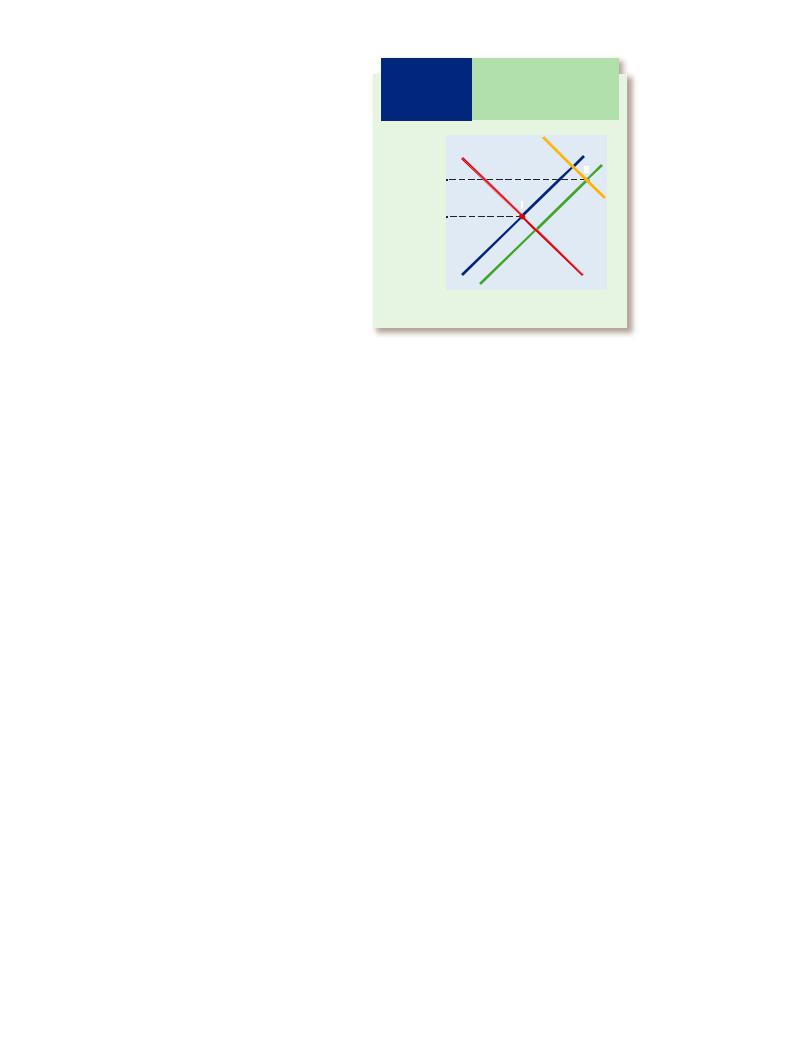
demand curve shifts further right (from D1 to D2) than the supply curve shifts right (from S1 to S2). As we can see in the exhibit, equilibrium price rises from $300 to $400. So, if both demand and supply increase and demand increases more than supply, the equilibrium price increases.
The change in equilibrium price will be determined by which changes more, supply or demand. If demand increases more than supply, the equilibrium price goes up. If supply increases more than demand, the equilibrium price will go down.
Does It Matter if Price Is at Its Equilibrium Level?
Think of two different worlds. World 1 has ten markets, each of which is in equilibrium. If all markets are in equilibrium, it means no shortages or surpluses of any good or service. In this world, buyers or sellers have no complaints. Everyone is happy.
World 2 also has ten markets, but in five of the ten markets price is below equilibrium price, and in five markets price is above equilibrium price. In other words, half the markets are in surplus, and half are in shortage. In this world, both buyers and sellers are complaining.
Which world would you rather live in? Can you see why economists think it is important to study and understand price and equilibrium?
Price Is a Signal
You are probably beginning to see that price has certain important jobs that it fulfills in the marketplace. One such job is to provide information, which it does in a kind of “market conversation.” For example, suppose for two goods—clocks and books— preferences one day shift against clocks and in favor of books. We know that a change in preferences affects the demand for both clocks and books. The demand for clocks will fall and the demand for books will rise.
What happens to price in each case? As a result of the decreased demand for clocks, the price of clocks falls. Because of the lower price for clocks, the quantity supplied of
E X H I B I T 6-4 Changes in
Both Supply and
Demand
|
|
S |
|
|
S2 |
|
|
2 |
|
$400 |
|
ce |
|
D2 |
i |
$ |
300 |
Pr |
||
|
|
D1 |
|
|
0 |
|
|
Quantity |
Sometimes supply and demand change at the same time. Here, although both demand and supply increase, demand increases more than supply. As a result, equilibrium price increases.
clocks falls. In other words, clock sellers will respond to the lower price for clocks by offering to sell fewer clocks. (The quantity supplied of clocks is lower at a lower price than at a higher price.)
As a result of the increased demand for books, the price of books rises. Because of the higher price for books, book sellers will offer to sell more books. In other
words, book sellers will respond to the higher price of books by offering to sell more books. (The quantity supplied of books is higher at a higher price than at a lower price.)
Notice how buyers are communicating with sellers. Buyers aren’t saying “produce fewer clocks and produce more books,” but the result is the same. Instead, buyers are simply lowering the demand for clocks and raising the demand for books. As a result, price goes down for clocks and up for books. Sellers see these price changes and respond to them. They decrease the quantity supplied of clocks and increase the quantity supplied of books. Price, then, acts as a signal that is passed along by buyers to sellers. As price goes down, buyers are saying to sellers “produce less of this good.” As price goes up, buyers are saying to sellers “produce more of this good.”
In this example, price is a signal that directs the allocation of resources away from clocks and toward books.
Section 1 Supply and Demand Together 137
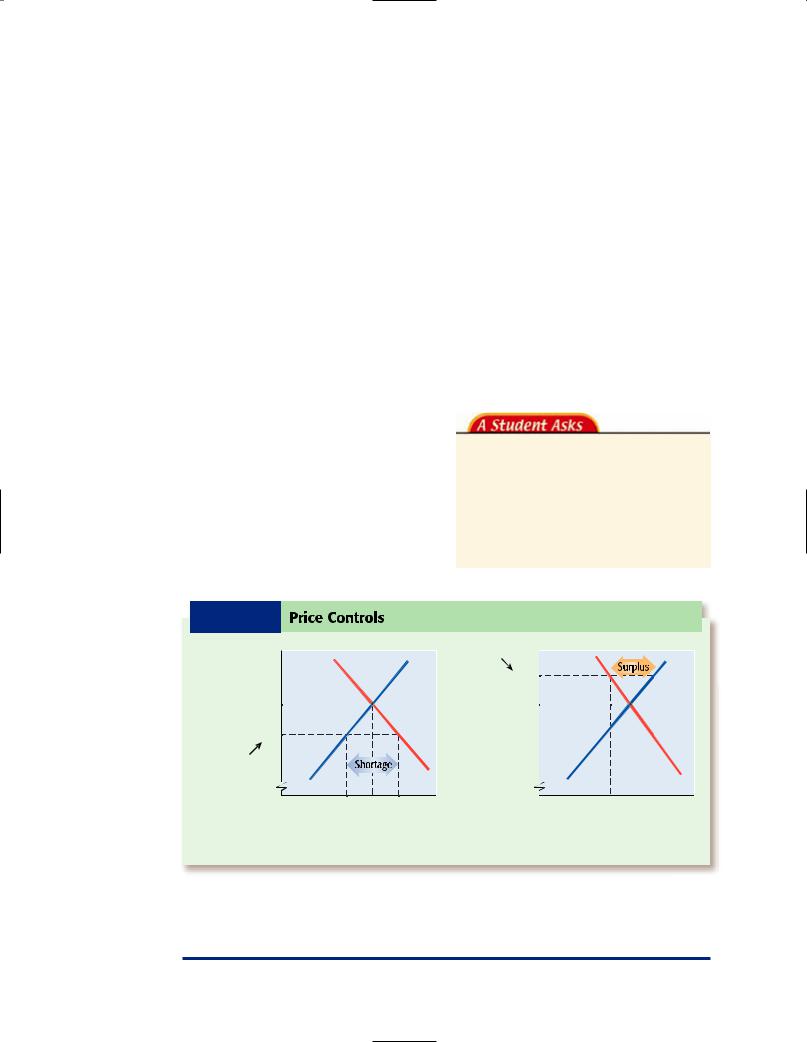
price ceiling
A legislated price—set lower than the equilibrium price—above which buyers and sellers cannot legally buy and sell a good.
price floor
A legislated price—set above the equilibrium price—below which buyers and sellers cannot legally buy and sell a good.
What Are Price Controls?
Sometimes government prevents markets from reaching an equilibrium price. For example, suppose that the equilibrium price for a good is $10. It is possible for government officials to pass a law setting the price lower—say, $8. A legislated price that is below the equilibrium price is called a price ceiling. A price ceiling is like a ceiling in a room. Just as you cannot go higher than the ceiling in a room, buyers and sellers cannot legally buy and sell a good for a price higher than the price ceiling.
Government could, and sometimes does, legislate a higher (than equilibrium) price— say, $12. A legislated price that is above the equilibrium price is called a price floor. A price floor is like a floor in a room. Just as you cannot go lower than the floor in a room, buyers and sellers cannot legally buy and sell a good for a price lower than the price floor.
Let’s look at both a price ceiling and price floor graphically. In Exhibit 6-5(a) we show a price ceiling. In the exhibit, $10 is the equilibrium price of the good. You will also notice that the equilibrium quantity is 80. The price ceiling of $8 is below the equilibrium price. What is an effect of the price ceiling? One effect is that a price ceiling creates a shortage
in the market. Notice that at $8, quantity demanded (100) is greater than quantity supplied (60), which is the definition of a shortage. Because suppliers only want to supply 60 units at $8, only 60 units are bought and sold. (Sure, buyers may want to buy 100 units at $8, but because suppliers only want to sell 60 units, they decide how much is bought and sold. You can’t make suppliers sell more of the good than they want to.)
Now look at Exhibit 6-5(b). Here you see a price floor of $12. What is an effect of the price floor? One effect is that a price floor creates a surplus in the market. Notice that at $12, quantity supplied (98) is greater than quantity demanded (65), which is the definition of a surplus. With the price floor, fewer units are bought and sold. Because buyers only want to buy 65 units at $12, only 65 units are bought and sold.
QUESTION: Why does government sometimes impose price controls (price ceilings and price floors)?
ANSWER: Sometimes government imposes a price ceiling on a good because it wants to make the good cheaper for
E X H I B I T 6-5 |
Price Controls |
|
|
|
|
|
|
|
|
|
S |
Price floor |
|
|
S |
|
|
|
|
|
|
||
|
|
|
|
$12 |
|
|
|
$10 |
|
|
|
$10 |
|
|
|
Price |
|
|
|
Price |
|
|
|
$8 |
|
|
|
|
|
|
|
Price ceiling |
|
|
|
|
|
|
|
|
|
|
|
D |
|
|
D |
|
|
|
|
|
|
|
|
0 |
60 |
80 |
100 |
0 |
65 |
80 |
98 |
|
Quantity |
|
|
Quantity |
|
||
|
|
(a) |
|
|
(b) |
|
|
The two types of price controls are price ceilings and price floors. (a) A price ceiling creates a shortage and reduces the quantity of the good bought and sold from what would be the case in equilibrium. (b) A price floor creates a surplus and reduces the quantity of the good bought and sold from what would be the case in equilibrium.
138 Chapter 6 Price: Supply and Demand Together
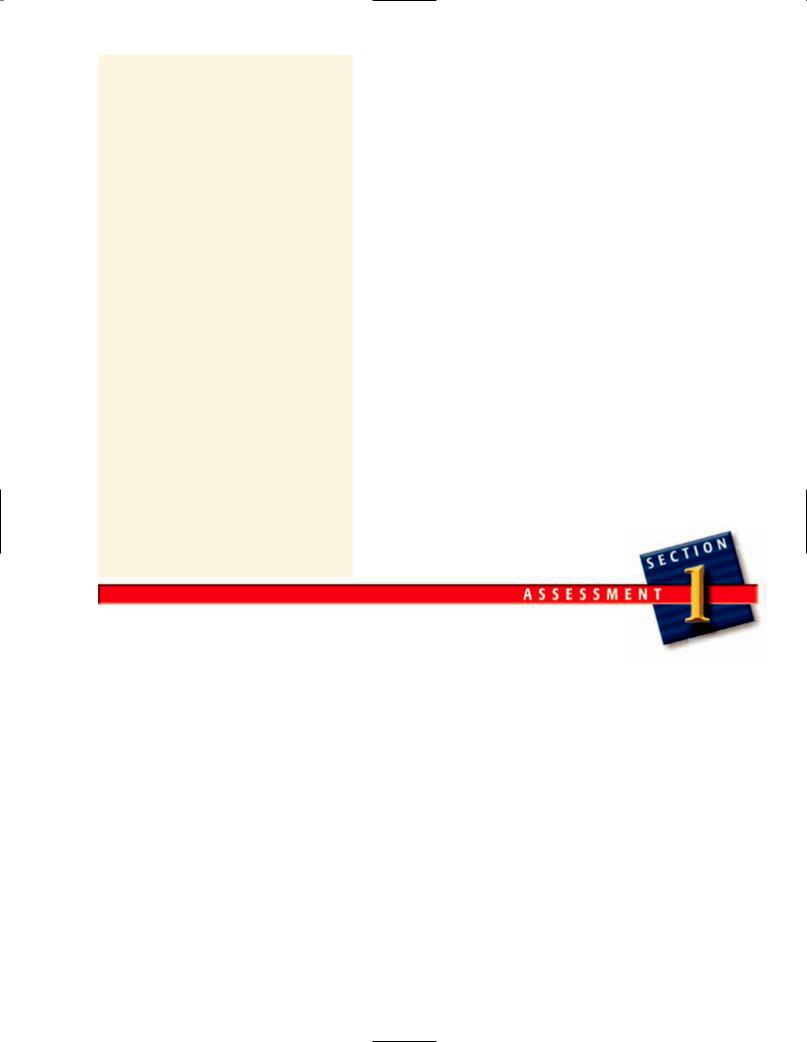
consumers to buy. For example, suppose the price of a particular medicine is $200 for a month’s supply. Government could impose a price ceiling on this medicine of, say, $100, with the hope that more people will be able to afford the medicine now. Of course, the unintended effect of this lower-than-equilibrium price is that a shortage will result. In other words, some of the people who need the medicine might not be able to buy the medicine at $100 because it is not available.
Sometimes government imposes a price floor because it wants to assist a certain group of producers. For example, farmers sometimes argue that they need to receive a higher dollar price for what they sell. Suppose that the equilibruim price for a bushel of corn is $3. Farmers argue that they can’t make a decent living at $3 a bushel. In response, government imposes a price floor of $4 on corn. Government says that no one can buy or sell corn for less than $4 a bushel. The intended effect of the price floor is to help farmers. The unintended effect, though, is to hurt the buyers of corn (they have to
Price Controls and the
Amount of Exchange
Price controls (price ceilings and price floors) bring about less exchange (less trade) than would exist without them. In Figure 6-5(a) the equilibrium quantity traded was 80, but the price ceiling reduced this level to 60. In Figure 6-5(b) the equilibrium quantity traded was 80, but the price floor reduced it to 65.
With this relationship in mind, let’s go back to something that you learned about voluntary exchange (or trade) in Chapter 2 and Chapter 3. In those chapters, you learned that exchange is something that makes people better off. If John exchanges his $15 for Yvonne’s book, John is, through his actions, saying that he is better off with the book than the $15. At the same time Yvonne is saying that she is better off with the $15 than she is with the book. In other words, exchange is something that makes both parties (the buyer and the seller) better off. If price controls decrease the amount of exchange that occurs, we must conclude that price controls limit the
Defining Terms
1.Define:
a.shortage
b.surplus
c.equilibrium (in a market)
d.equilibrium quantity
e.equilibrium price
f.inventory
g.price ceiling
h.price floor
Reviewing Facts and
Concepts
2.If demand increases and supply is constant, what happens to equilibrium price?
3.If supply decreases and demand is constant, what happens to equilibrium price?
4.If supply increases and demand is constant, what happens to equilibrium price?
5.If the shortage is 40 units and the quantity supplied is 533 units, then what does quantity demanded equal?
6.If supply decreases by more than demand decreases, what happens to equilibrium price?
Critical Thinking
7.A producer makes 100 units of good X at $40 each. Under no circumstances will he sell the good for less than $40. Do you agree or disagree? Explain your answer.
Graphing Economics
8.Graph the following:
a.Demand increases in a market.
b.Supply decreases in a market.
c.Demand decreases in a market.
d.Demand increases by more than supply increases in a market.
Section 1 Supply and Demand Together 139

Supply and
Demand in
Everyday Life
Focus Questions
Why do people wait in long lines to buy tickets for some rock concerts?
Why does a house cost more in San Francisco than in Louisville, but a candy bar costs the same in both cities?
Why does it cost more to go to the movies on Friday night than on Tuesday morning?
What does traffic congestion have to do with supply and demand?
What does trying out for a high school sports team have to do with supply and demand?
What is the necessary condition to earn a high income?
Why the Long Lines for Concert Tickets?
Suppose tickets for a rock concert go on sale at 8 a.m. on Saturday. A long line of people forms even before the ticket booth opens. The average person has to wait an hour to buy a ticket. Some people don’t get to buy tickets at all because the concert sells out before they get to the ticket booth.
Why do so many people wait in line to buy tickets to the rock concert, yet you don’t see a long line of people waiting to buy food at the grocery store or TVs at the electronics store? Also, why are some of the people waiting to buy tickets to the rock concert turned away, but no one who wants to buy bread is turned away at the grocery store, and no one who wants to buy a TV set is turned away at the electronics store? The market for the rock concert tickets (at least in this instance) must differ somehow, but how?
In economic terms, when some people go away without being able to buy what they came to buy, it means that quantity demanded exceeds quantity supplied, resulting in a shortage in the market.
You learned earlier that a market shortage causes price to rise. Eventually, it will rise to its equilibrium level. The problem in the rock concert example, though, is that the tickets were bought and sold before the seller realized a shortage of tickets would occur. In hindsight, the seller knows that the price charged for the tickets was too low, and this pricing caused a shortage. If the seller had charged the equilibrium price, he would have encountered no shortage, no long lines, and no one turned away without a ticket.
As shown in Exhibit 6-6, the seller charged $40 a ticket. At this price, quantity demanded (12,500) was greater than quantity supplied (10,000). If the price had been $60 a ticket, quantity supplied (10,000) would have equaled quantity demanded (10,000), and no shortage would have happened.
Why didn’t the seller charge the higher equilibrium price, instead of a price that was too low? The seller might have charged the equilibrium price had she known it. Think back to the auctioneer example. Note that the auctioneer did not call out the equilibrium price at the start of the auction. He called out $6, which was too high a price,
140 Chapter 6 Price: Supply and Demand Together

which created a surplus. Later, he called out $2, which was too low a price, causing a shortage. It was only through trial and error that the auctioneer finally hit upon the equilibrium price. Because people come to the grocery store and electronics store to buy goods every day, those stores have countless opportunities to learn by trial and error and adjust their prices to reach equilibrium. The seller of the rock concert tickets did not have the same opportunity.
QUESTION: At a concert I attended last month, scalpers were selling tickets for at least $50 more than the original price of the ticket. Tickets that were initially sold for $60 were being sold by scalpers for $110. Aren’t the scalpers, in a way, like the auctioneer?
ANSWER: Yes. Look again at Exhibit 6-6. We can see that the equilibrium ticket price (for this particular concert) is $60, but the initial ticket seller sells tickets for only $40. What will happen in this case is that someone is likely to buy a ticket (or two, or three, or four) for $40 and then resell the ticket for $60, for a profit of $20 per ticket. Now ask yourself whether this buying and reselling of tickets would happen if all tickets were sold for $60 in the first place. The answer is no. Lesson learned: Scalpers (people who buy and resell tickets at higher prices) will only exist if the good in question was not originally sold at its equilibrium price.
Look around you. You don’t see scalpers when it comes to milk, computers, rugs, shirts, turkey sandwiches, or cups of coffee. No person stands outside a coffee shop and offers to sell you a cup of coffee for $2 more than you can pay for a cup of coffee inside the shop. The reason you don’t see any scalpers in these cases is because the prices of the goods are at equilibrium.
Still, you will see a scalper for a rock concert, or some sporting events, or even some plays. Why? Because in these cases, the price initially charged for these
E X H I B I T 6-6 Rock Concert
Ticket Price
S
$60
Price
$40
D
0 |
10,000 |
12,500 |
Number of tickets
The seller of rock concert tickets sells 10,000 tickets at a price of $40 each. At this price, a shortage occurs; the seller charged too low a price. A price of $60 per ticket would have achieved equilibrium in the market.
events was below the equilibrium price; that is, the price was below the price at which quantity demanded equals quantity supplied.
The Difference in Prices for Candy Bars, Bread, and Houses
In general, no matter where you go in the United States, the price of a candy bar (pick your favorite brand) is approximately the same. A candy bar in Toledo, Ohio, is approximately the same price as a candy bar in Miami, Florida. This consistency is true for the most part for many other goods, such as a loaf of bread, for example.
But is it true for all goods? What about real estate prices—in particular, the price of a house in San Francisco, California, and the price of a similar house in a similar neighborhood in Louisville, Kentucky? The house in San Francisco will sell for approximately three to four times the price of the house in Louisville. Why, when it comes to candy bars and bread, does a good sell for approximately the same price no matter where it is purchased in the United States, whereas a house purchased in San Francisco is so much more expensive than a similar house in Louisville? Supply and demand give us the answer.
Section 2 Supply and Demand in Everyday Life 141

Although similar in style and size, houses in different geographic locations often sell at prices differing in the hundreds of thousands of dollars. What similar products do not differ in price from location to location? Why?
Let’s imagine for a second that the price of a candy bar is not the same in Toledo as in Miami. At a particular point in time the price for candy bars is $2 in Toledo and $1 in Miami, because the demand for candy bars is higher in Toledo. Knowing what you know now about supply and demand, what do you think will happen?
Given the price difference, the suppliers of candy bars will prefer to sell more of their product in Toledo than in Miami, so the supply of candy bars will increase in Toledo and decrease in Miami. Then what will happen? The price of a candy bars will decrease (say, from $2 to $1.50) in Toledo and increase (say, from $1 to $1.50) in Miami. Only when the prices of candy bars are the same in Toledo and Miami will suppliers no longer have an incentive to rearrange the supply of candy bars in the two cities. The same type of activity would affect the price of bread in the two cities. When suppliers can shift supply from one location to another, price will tend to be uniform for products.
Now consider houses in different cities. Housing prices are much higher in San Francisco than in Louisville because the difference between demand and supply (more demand, less supply) in San Francisco is greater than it is in Louisville. If houses were candy bars or bread, suppliers would shift their supply from Louisville to San Francisco. However, houses are built on land, and the price of the land is part of the price of a house. Naturally, suppliers cannot
pick up an acre of land in Louisville and move it to San Francisco.
So, what have we learned? When the supply of a good cannot be moved in response to a difference in price between cities, prices for this good are likely to remain different in these cities.
QUESTION: I was in both Oklahoma and California this past summer and the price of gas was higher in California than in Oklahoma. Gas is something that can be moved from place to place (by trucks). So why wasn’t the price of gasoline the same in the two locations?
ANSWER: Good question. The major reason for the difference you noticed is that taxes on gasoline are different in different states. Many states (and counties too) place an excise tax on gasoline. An excise tax is a tax on the manufacture or sale of a particular good. For example, in Florida gasoline is subject not only to a state excise tax but a county excise tax in many cases as well. State and county excise taxes differ across the country. It so happens that excise taxes on gasoline are less in Oklahoma than in California. This difference in excise taxes often explains why you might pay more for a gallon of gasoline in one state than you pay in another.
142 Chapter 6 Price: Supply and Demand Together

Supply and Demand
at the Movies
Have you noticed that the prices for movie tickets can vary? If you want to see a movie on Friday night, you may have to pay $8, but for the same movie at 11:00 a.m. on Tuesday, you may have to pay only $3.50. The difference depends on supply and demand. Certainly the supply of seats in the theater is the same Friday night as Tuesday morning. The demand, however, is different. The demand to see a movie on Friday night is higher than on Tuesday morning, and the higher demand makes for a higher price.
Supply and Demand on a Freeway
Supply and demand are easy to see at a rock concert, a movie theater, or the grocery store. But supply and demand also appear in places we wouldn’t initially think to look, such as on a freeway. Suppose a certain supply of freeway space consists of a certain number of lanes and miles. Also, the
What was the ticket price for a movie in 1948? In 1962? In 1974? Here are the “average” ticket prices for the period 1948–2004.
Year |
Price |
|
Year |
Price |
|
Year |
Price |
1948 |
$ .36 |
1981 |
$2.78 |
1994 |
$4.08 |
||
1954 |
.49 |
1982 |
2.94 |
1995 |
4.35 |
||
1958 |
.68 |
1983 |
3.15 |
1996 |
4.42 |
||
1963 |
.86 |
1984 |
3.36 |
1997 |
4.59 |
||
1967 |
1.22 |
1985 |
3.55 |
1998 |
4.69 |
||
1971 |
1.65 |
1986 |
3.71 |
1999 |
5.06 |
||
1974 |
1.89 |
1987 |
3.91 |
2000 |
5.39 |
||
1975 |
2.03 |
1988 |
4.11 |
2001 |
5.65 |
||
1976 |
2.13 |
1989 |
3.99 |
2002 |
5.80 |
||
1977 |
2.23 |
1990 |
4.22 |
2003 |
6.03 |
||
1978 |
2.34 |
1991 |
4.21 |
2004 |
6.21 |
||
1979 |
2.47 |
1992 |
4.15 |
Source: Motion Picture |
|||
1980 |
2.69 |
1993 |
4.14 |
Association of America. |
|||
demand for freeway space is equal to the demand people have to drive on freeways.
The demand to drive on a freeway is not always the same, of course. The demand is higher at 8 a.m. on Monday, when people are driving to work, than at 11 p.m. You can see this demand represented in Exhibit 6-7(a). The supply curve, S1, represents the
E X H I B I T 6-7 SupplyPrice Controlsand Demand on a Freeway
The price that would eliminate freeway congestion at 8 a.m.
The price charged to drive on the freeway at 11 p.m. and 8 a.m.
Price |
S1 |
$1.50 |
D |
|
|
|
8 a.m. |
D |
Shortage |
11 p.m. |
|
0 |
Freeway space |
|
|
|
|
|
|
|
|
|
|
|
|
(a) |
|
|
|
|
|
|
|
|
|
|
|
|
|
S1 |
|
S2 |
|
D |
|
|
|
|
|
S1 |
|
|
|
|
|
|
|
|||||
|
|
|
|
|
|
|
|
|
|
D |
|
Price |
|
|
|
|
8 a.m. |
Price |
|
|
|
|
8 a.m. |
|
|
|
|
|
|
D |
|
|
without |
||
|
D |
|
|
|
|
|
|
8 a.m. |
|
|
carpooling |
|
|
|
|
|
|
|
|
|
|
||
|
11 p.m. |
|
|
|
|
|
|
with |
|
|
|
|
|
|
|
|
|
|
|
carpooling |
|
|
|
0 |
|
|
|
|
|
|
0 |
|
|
|
|
Freeway space |
|
|
Freeway space |
||||||||
|
|
|
|
||||||||
|
|
(b) |
|
|
|
(c) |
|||||
Freeway congestion can be solved by
(a)charging a toll,
(b)increasing supply, or (c) reducing demand.
Section 2 Supply and Demand in Everyday Life 143
